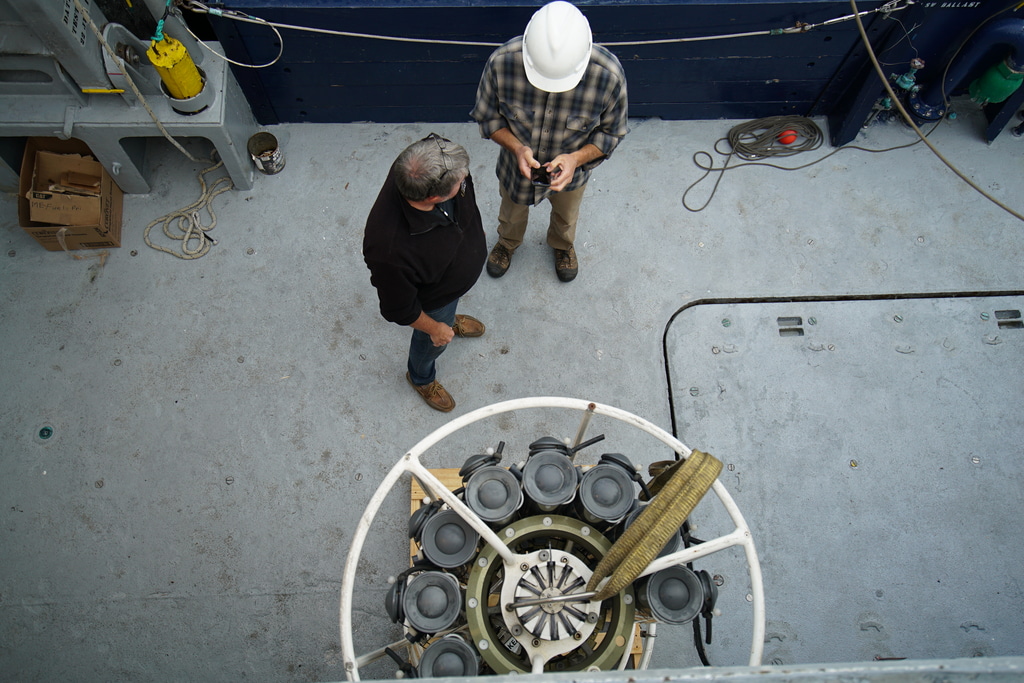Instruments in the Sea and Sky: NASA’s S-MODE Mission Kicks off
Using instruments at sea and in the sky, the Sub-Mesoscale Ocean Dynamics Experiment (S-MODE) team aims to understand the role these ocean processes play in vertical transport, the movement of heat, nutrients, oxygen, and carbon from the ocean surface to the deeper ocean layers below. In addition, scientists think these small-scale ocean features play an important role in the exchange of heat and gases between air and sea. Understanding small-scale ocean dynamics will help scientists better understand how Earth’s oceans slow the impact of global warming and impact the Earth climate system.
From its vantage 28,000 feet in the air aboard the NASA Armstrong King Air B200, the DopplerScatt instrument bounces radar signals off the ocean to provide information about winds and currents at the surface. The MASS instrument aboard the Twin Otter DHC6 plane flies below the clouds to observe how surface waves move and break. It collects measurements with a complex suite of laser-based and imaging devices, which allow the team to infer ocean currents from these measurements.
Several Saildrones set sail from San Francisco Bay to join the S-MODE fleet collecting data at the study site. The Saildrones and Wave Gliders will measure a vast array of factors such as ocean currents, wind speed and direction, air and water temperature, salinity, dissolved oxygen, and chlorophyll content.

On Oct. 19, the research vessel Oceanus, owned by the National Science Foundation, set sail to an area a hundred nautical miles out to sea off the coast of San Francisco, accompanied by a fleet of several types of autonomous marine research vehicles.

On Oct. 19, the research vessel Oceanus, owned by the National Science Foundation, set sail to an area a hundred nautical miles out to sea off the coast of San Francisco, accompanied by a fleet of several types of autonomous marine research vehicles.

On Oct. 19, the research vessel Oceanus, owned by the National Science Foundation, set sail to an area a hundred nautical miles out to sea off the coast of San Francisco, accompanied by a fleet of several types of autonomous marine research vehicles.

On Oct. 19, the research vessel Oceanus, owned by the National Science Foundation, set sail to an area a hundred nautical miles out to sea off the coast of San Francisco, accompanied by a fleet of several types of autonomous marine research vehicles.

On Oct. 19, the research vessel Oceanus, owned by the National Science Foundation, set sail to an area a hundred nautical miles out to sea off the coast of San Francisco, accompanied by a fleet of several types of autonomous marine research vehicles.

On Oct. 19, the research vessel Oceanus, owned by the National Science Foundation, set sail to an area a hundred nautical miles out to sea off the coast of San Francisco, accompanied by a fleet of several types of autonomous marine research vehicles.

On Oct. 19, the research vessel Oceanus, owned by the National Science Foundation, set sail to an area a hundred nautical miles out to sea off the coast of San Francisco, accompanied by a fleet of several types of autonomous marine research vehicles.

On Oct. 19, the research vessel Oceanus, owned by the National Science Foundation, set sail to an area a hundred nautical miles out to sea off the coast of San Francisco, accompanied by a fleet of several types of autonomous marine research vehicles.

On Oct. 19, the research vessel Oceanus, owned by the National Science Foundation, set sail to an area a hundred nautical miles out to sea off the coast of San Francisco, accompanied by a fleet of several types of autonomous marine research vehicles.
Credits
Please give credit for this item to:
NASA's Goddard Space Flight Center
-
Producers
- Kathleen Gaeta (Advocates in Manpower Management, Inc.)
- Ellen T. Gray (ADNET Systems, Inc.)
-
Writer
- Sofie Bates (KBR Wyle Services, LLC)
-
Technical support
- Kathryn Mersmann (KBR Wyle Services, LLC)
- Aaron E. Lepsch (ADNET Systems, Inc.)
-
Videographer
- Jesse Carpenter (Mori Associates Inc)
Release date
This page was originally published on Friday, October 29, 2021.
This page was last updated on Wednesday, May 3, 2023 at 1:43 PM EDT.

![Music: Spirit of Africa by Anders Paul Niska [STIM] and Klas Johan Wahl [STIM]; Speed Jazz by Gavin Griffiths [PRS]; Snowfall by Andy Blythe [PRS] and Marten Joustra [PRS], Heavy Weather by Russel Emanuel [PRS] and Dolph Taylor [PRS]Complete transcript available.](/vis/a010000/a013500/a013515/Map_Still_print.jpg)